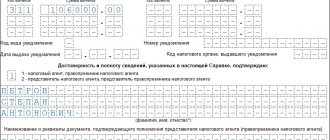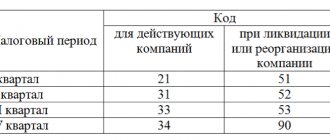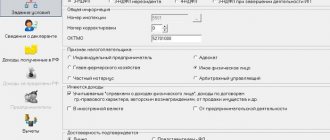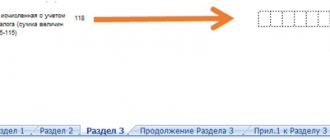In accordance with the norms of the Tax Code of the Russian Federation, individual entrepreneurs and organizations have the opportunity to replace declarations for various taxes with one document - a single simplified tax return.
In our article we will look at when, where and how to submit this document, and will dwell on the main points of filling it out.
At the bottom of the page, the reader can find a single simplified tax return for 2021, as well as a sample for filling out this document.
Who can file a single simplified tax return?
This document can be submitted by:
- taxpayers who have no transactions that resulted in the movement of funds at the cash desk and in current accounts (in banks);
- taxpayers for taxes for which there are no objects of taxation - sales of goods and services, income, property.
Fulfillment of these conditions indicates that the individual entrepreneur is just starting his entrepreneurial activity or that the activity is not actually being carried out.
In what cases is this declaration submitted?
A single simplified tax return in 2021 is submitted subject to certain conditions. Namely:
1. The taxpayer did not carry out cash transactions, or there were no cash flows in the current account. 2. The document can be submitted only for taxes for which there are no objects of taxation (for example, property, sale of services or goods).
Thus, the fulfillment of these conditions indicates that the taxpayer did not conduct business activities or is a newly registered individual entrepreneur who has just started working.
Due to the fact that fulfillment of such conditions is extremely rare, a single simplified declaration is not popular among entrepreneurs. The fact is that some entrepreneurs incorrectly believe that they have the right to file a single simplified tax return if they have no profit or did not provide services, but this is incorrect. Indeed, in this case, cash flow includes not only income, but also expenses of the organization.
When and where should the declaration be submitted?
If filing a return for a specific tax, for example, the simplified tax system, is provided for at the end of the calendar year, then it is not necessary to submit it quarterly.
A single simplified declaration is submitted to the tax office:
- Individual entrepreneur - at the place of residence;
- organization - at its location.
Due date: no later than the 20th day of the month following the reporting quarter, half-year, nine months, or year.
A single simplified tax return in 2021 must be submitted within the following deadlines:
- for twelve months of 2021 – until January 20, 2021;
- for the first three months of 2021 – until April 20, 2021;
- for the first half of 2021 – until April 20, 2021;
- for nine months of 2021 – until October 20, 2021;
- for the twelve months of 2021 – until January 20, 2021.
Tax payment deadlines
The Tax Code of the Russian Federation provides for the calculation and transfer of advance tax payments, as well as the transfer of the annual payment calculated for payment according to the declaration, which takes into account interim payments.
Transfer of advance payments is made once per quarter, after it ends before the 25th day of the month following the reporting period. For the first quarter, payment must be made by April 25, for the six months - by July 25, for 9 months - by October 25.
For annual payments, the deadlines for sending the declaration using the simplified tax system coincide with the tax payment periods and also depend on who the business entity is:
- For organizations - until March 31 of the reporting year.
- For individual entrepreneurs - until April 30 of the reporting year.
Ways to file a return in 2021
Today, there are three ways for taxpayers to file a simplified return, namely:
- Electronically via the Internet - under an agreement through EDF or using the service on the Federal Tax Service website.
- On paper in 2 copies.
- By mail (with a description of the attachment).
If an individual entrepreneur submits a single simplified tax return not in person, but with the help of an authorized person, it is necessary to issue a notarized power of attorney.
Information reflected in the document
Before you fill out the simplified tax return for 2018, you need to know what information is reflected in it:
- When paying a tax liability on profits received during the reporting period, the document indicates the amount of income received and the amount of allowed expenses (when calculating the tax base as income minus expenses).
- The amount of accrued and paid insurance premiums and payments to employees for the period of temporary disability is reflected. Including the amount of the paid trade tax, provided that the enterprise carries out economic activities subject to payment of this fee.
- The amount of accrued advances, as well as paid to the budget. At the end of the tax period (year), the amount of advance payments reduces the amount of tax payable.
The new form of the simplified tax return for 2021 was approved by Order of the Federal Tax Service No. MMV-7-3/99 dated February 26, 2021. If in 2021 taxpayers were allowed to use the old sample tax document, then in 2021 everyone will be required to use the new tax reporting.
Tax return simplified tax system (form)
Rules for filling out the declaration in 2021
The form of a single simplified declaration (USD) was approved by Order of the Ministry of Finance of the Russian Federation No. 62 on July 10, 2007. To date, the EUD form has not changed and remains relevant in 2021.
When filling out a single simplified declaration, it is important to follow a number of rules. The basic rules for filling out this document are as follows:
- The declaration can be filled out either by hand or using a computer.
- Individual entrepreneurs (organizations) fill out only the first page of the document.
- When filling out the declaration, you can use blue or black ink.
- Two pages of the document are filled out by individuals (who are not individual entrepreneurs) and do not want to indicate their TIN.
- It is unacceptable to correct errors in the declaration.
Who rents
A single simplified declaration can be used in accordance with paragraph 2 of Article 80 of the Tax Code of the Russian Federation. The KND reporting form 1151085 and the procedure for filling it out were approved by Order of the Ministry of Finance No. 62n dated July 10, 2007.
A single simplified tax return can be submitted by taxpayers who:
- just registered and did not carry out economic activities during the reporting period, that is, there were no incomes or expenses;
- did not carry out any banking operations, that is, the bank should not write off a commission for maintaining this current account, and the organization should not receive and pay money;
- did not carry out any cash transactions;
- completely suspended economic activities.
Individual entrepreneurs (IP) or organizations, instead of zero tax returns, can submit a single simplified declaration (SUD) to the Federal Tax Service.
Filling out Page 1
Field "TIN":
Individual entrepreneurs and organizations indicate their TIN (in accordance with the received certificate of registration with the tax office).
Field "Checkpoint":
Individual entrepreneurs do not fill out this field, but organizations indicate the checkpoint received from the Federal Tax Service (at the location of the organization).
Field "Document type":
- if the declaration is submitted for the first time during the tax period - put “1 / - “;
- if the first correction is “3/1”;
- if the second correction is "3/2".
Field "Reporting year":
The year for which the declaration is submitted is entered.
Field "Represented in":
The name of the tax office to which the declaration is submitted is indicated. If a document is submitted by an individual. by a person - his last name, first name, patronymic (in accordance with passport data) is indicated without abbreviations; for organizations - full name.
Field "OKATO Code":
From January 1, 2014, the OKATO code is indicated in the field instead of the OKATO code:
This field indicates the activity code in accordance with the OKVED classifier. OKVED codes are contained in the extract from the Unified State Register of Legal Entities (USRLE).
Features of filling out a zero declaration under the simplified tax system
If the company was not engaged in activities during the period of filing the report, then the declaration under the simplified tax system must still be sent in accordance with the established deadlines. The main feature in this case is the inclusion of zero values in key columns.
If the subject uses the “Income” type, then the title page is filled out in full. Next, you need to fill out the sheet containing section 1.1. It is necessary to enter data in column 010. Columns 030, 060 and 090 contain data only if the organization’s address changed during the period, and for this reason the OKTMO code changed. Other columns on this sheet must contain dashes.
Also in the declaration you need to include a sheet with section 2.1.1, where the data is recorded in column 102, and the tax rate is also indicated in columns 120-123. Other columns are crossed out.
When using the “Income reduced by expenses” system, the declaration begins with a title page. After this, it is necessary to enter the OKTMO code in column 010 on the sheet with section 1.2. Columns 030, 060 and 090 are filled in if the address of the activity changes during the period. All other available columns are crossed out.
Next, take a sheet with section 2.2, in which columns 260-263 are filled in by indicating the tax rate used. All other columns are crossed out.
Filling out the tax table:
Columns 1 and 2:
The columns indicate line by line the taxes for which the declaration is provided. Taxes must be entered in accordance with the numbering of chapters of part two of the Tax Code of the Russian Federation (for these taxes).
Below is Appendix 1. In column 2 of this Appendix indicate the number of the head of the Tax Code of the Russian Federation.
Columns 3 and 4:
If the tax period is a quarter, then enter 3 in the corresponding cell (columns 3). In column 4 indicate the number of the quarter for which the tax return is filed:
- I quarter - 01;
- II quarter - 02;
- III quarter - 03;
- IV quarter - 04.
For a tax for which the tax period is a calendar year (and the reporting periods are quarter, half-year and nine months), then in the corresponding cell (columns 3) indicate the value of the tax period:
- quarter - 3;
- half-year - 6;
- 9 months - 9;
- year - 0.
A dash is placed in the column.
Field “Taxpayer contact telephone number”:
Specified in any format.
Field “The declaration is drawn up on pages”:
The number of pages that make up the declaration is indicated (for example, “002”).
Field “with supporting documents or copies thereof”:
The number of sheets of documents that are attached to the declaration is indicated. If such documents are missing, a dash is added.
Block “I confirm the power of attorney and the completeness of the information specified in this declaration”:
- if the declaration is submitted by an individual. person (IP) - only the signature and date of signing of the declaration are placed;
- if the declaration is submitted by an organization, the full name of the head is indicated, the signature, date and seal of the organization are affixed;
- if the declaration is submitted by a representative, the name of the document confirming his authority is indicated.
Sample of filling out a declaration according to the simplified tax system
Title page
At the top of such a sheet you need to enter the TIN and KPP numbers of the business entity using the simplified tax system. At the same time, we must remember that a legal entity’s TIN includes 10 characters and there is a checkpoint code. For entrepreneurs, the number of characters in the TIN is 12, and there is no checkpoint code.
All remaining empty cells must be crossed out.
After specifying the name of the declaration, its code is displayed:
- 0 — for the primary report;
- 1, 2, etc. – for correctors in order of priority.
Next, using a digital code, you need to indicate the period for which the report is being submitted:
- 34 - regular simplified declaration for the year
- 50 - if the business entity has closed its activities
- 95 - for reporting during the period of transition from the simplified tax system to another regime
- 96 - if the simplified tax system was previously combined with other modes (for example, UTII) and activities on the simplified tax system were discontinued.
In the “Reporting period” field, you must enter in numbers the year for which this declaration is being sent.
The four-digit code of the Federal Tax Service, which is the recipient of this report, is recorded nearby.
Here you need to indicate in code where the declaration is sent:
- 120 - is entered by the entrepreneur who submits the report at the place of his registration.
- 210 - is affixed by the legal entity that rents it out at its location.
- 215 - affixed by the successor company.
The four lines below are intended to indicate the full name of the organization or personal data of the entrepreneur. In this case, for individual entrepreneurs, each word must be entered on a new line. We must remember that empty lines should be crossed out.
Next, indicate the code of the activity of the business entity, which is recorded in the registration data. It must comply with the OKVED2 directory.
Then information is provided in cases where the company was reorganized. Here you need to reflect the code of the transformation being carried out, the tax identification number and checkpoint of the new company.
The next line indicates the telephone number by which the inspector of the Federal Tax Service can, if necessary, contact the responsible person of the company to clarify the information.
Below is the total number of sheets of the tax return, as well as how many sheets there are annex to it.
After this, the business entity must fill out only the left side of the page.
Here the code reflects who submits the report to the Federal Tax Service:
- 1 - the taxpayer himself.
- 2 - person by proxy. The full name, representative or name of the legal entity acting by proxy is also written down here.
The date of submission of the document is indicated at the bottom and a signature is placed. When a report is submitted by a representative, it is also necessary to indicate here the name, number and date of the document giving him authority.
Example of filling out the simplified tax system for income
If a business entity is accounted for in the “Income” system, then in the declaration, in addition to the title page, it must include sheets with sections 1.1 and 2.1.1. In addition, if he is identified as a payer of the trade tax, then it is also necessary to draw up a sheet with section 2.1.2. The remaining sheets are not used and are not included in the declaration.
Section 1.1
At the top of the sheet are the numbers of the TIN, checkpoint, and sheet in the declaration pack.
Columns 010, 030, 060 and 090 reflect the OKTMO corresponding to the place of business or registration. It is imperative to indicate the value only in column 010. The rest are filled in only in a situation where there was a change in the place of activity during the billing period.
Column 020 records the result of subtracting columns from section 2.1.1 - 130 and 140. If the subject pays a trading fee, then the value of column 160 of section 2.1.2 must be subtracted from the indicated value. The total is entered in the column only if it is greater than zero.
For column 040, the total is calculated using the formula: pp 131-141-161-020. The values for columns 131 and 141 are taken from section 2.1.1, and columns 161 from section 2.1.2.
For column 070, the result is calculated using the formula: 132-142-162-020-040. The values of columns 132 and 142 are also transferred from section 2.1.1, and columns 162 - from section 2.1.2.
Line 100 is the amount that needs to be paid based on the results of the year. At the same time, column 110 is the amount of payments by which the amount of tax can be reduced. The general formula for calculating the result for column 100 looks like this: 133-143-163-020-040-070. A negative value does not fit into the column.
The value in column 110 is entered only if, after the calculation, the total in column 100 is negative.
Section 2.1.1
At the top of the page there are INN and KPP codes and the sheet number in the declaration.
A code indicating the presence of hired workers is entered in the following column:
- 1 — Hired employees are present;
- 2 - An entrepreneur conducts his business alone.
In columns 110-113 the amounts of income received for each billing period are entered. The data in them is indicated in ascending order.
In columns 120-123 you need to enter the tax rate that the business entity used in the specified period.
Columns 130-133 indicate the resulting tax amount. It is found by multiplying the amount of income from columns 110-113 by the rate from columns 120-123, after which the result is divided by 100.
In columns 140-143 the amounts of expenses are entered for which, according to the Tax Code, the subject has the right to reduce the amount of tax paid. This includes, for example, fixed payments to individual entrepreneurs for themselves. These columns must also be filled in on a cumulative basis.
If an organization or entrepreneur has employees (code 1 was indicated), then by law he has the right to reduce the amount of tax by no more than 50%.
But individual entrepreneurs operating independently (code 2 was indicated) are entitled to reduce the tax by the entire transferred amount. To determine the size of the reduction, use the employee availability code, which is written at the very beginning of the sheet.
Section 2.1.2 (Trade Tax Payers Only)
The declaration under the simplified tax system must include a sheet with the named section only when the business entity is the payer of the fee.
In columns 110-113, income from the activities for which the trade fee is transferred is entered. The data is indicated as a total with an increase for each period - quarter, half-year, 9 months and year.
Information in columns 130-133 is entered after multiplying income from columns 110-113 and tax rates from columns 120-123 of section 2.1.1. The total must be divided by 100.
In columns 140-143 you can indicate the amounts by which the tax amount is reduced (these include transferred contributions).
If the business entity drawing up the declaration maintains only a single type, and the trade fee is transferred according to it, then the information from the columns of this section will repeat the data from the columns of section 2.1.1. Otherwise, it is necessary to make separate records of income received and transferred contributions for ongoing activities.
Lines 150-153 show the amount of trading fee transferred to the budget in each billing period. The data is indicated in total from the beginning of the year.
Columns 160-163 record the amount of the trade fee by which it is allowed to reduce the amount of tax paid.
In a situation where the calculated amounts of the trade tax are greater than or equal to the amounts of the tax reduced by deductions, then the simplified tax amount must be entered into these drains. Otherwise, the values from columns 150-153 are transferred to these columns.
Example of filling out the simplified tax system for income reduced by expenses
When applying the simplified tax system, income minus expenses, in addition to the title page, sheets containing sections 1.2 and 2.2 must be filled out. And if the company had target revenues in the reporting period, then the report must include a sheet with section 3. Sheets that relate to the “Revenue” system are not included in this declaration.
Section 1.2
At the top of the sheet are the TIN and checkpoint codes, as well as the serial number in the pack.
In columns 010, 030, 060 and 090 OKTMO codes are written corresponding to the address at which the organization operates or the entrepreneur is registered. It is mandatory to indicate the value only in column 010. The rest are filled in only in cases of change of address during the reporting period. Otherwise, these fields must be crossed out.
The value calculated in column 270 of section 2.2 is transferred to column 020.
Column 040 records the amount that is obtained by subtracting the results of column 271 and column 020. If the resulting value is negative, then column 040 should be crossed out, and the total transferred to column 050 without putting a minus sign.
The result for column 070 is calculated using the formula 272-020-040+050 and represents the amount of tax payable for the specified period. If after the calculation a negative value is obtained, then this column must be crossed out and the result written in column 080 without the minus sign.
In column 100 the result of the calculation is entered using the following formula: 273-020-040+050-070+080. If a negative value was received, then it must be entered in column 110 without a negative sign.
If the final result in column 280 from section 2.2 is greater than the result in column 273 of the same section, then it is necessary to fill out column 120. This means that the organization must transfer the minimum tax. Its value must be calculated using the following formula: line 280 - (020-040+050-070+080). If the result is a negative value, then it is indicated in column 110 without the minus sign.
Section 2.2
At the beginning of the sheet you need to put down the TIN and KPP codes, as well as its serial number in the general packet of the report.
In columns 210-213, the amounts of income received for 3 months, six months, 9 months and a year are recorded on an accrual basis.
Further, in columns 220-223 the amount of expenses incurred for similar periods is indicated. They are also recorded on an accrual basis, and must meet the criteria established in the Tax Code.
In line 230 you can record the amount of loss that was incurred in previous years. However, this can only be done if the amount of income exceeds the expenses incurred.
The tax base for calculating the tax amount is entered in lines 240-243. It is found by subtracting the result from the result of lines 210-213 of the information in lines 220-223. The total is indicated for each period - quarter, half-year, 9 months and full year.
In these lines you can specify values strictly greater than zero. If a loss is received, then you need to fill out the next block of the column.
If the entity received less income than it incurred expenses (i.e. suffered losses), then columns 250-253 must be filled out. The values must be entered in them without the minus sign.
In columns 260-263 the rate at which the amount of tax is calculated in each period is recorded. By law it is equal to 15%. Regions are allowed to set the rate at their own discretion (from 0 to 15%), but in most cases the base value is used.
Columns 270-273 record the amount of tax payable for each reporting period. The value is formed by multiplying the resulting tax base by the rate. For example, the calculation for column 270 is obtained by the formula: column 240 x column 260 / 100.
If a loss has occurred, this block is not filled in, but crossed out.
Column 280 records the amount of the minimum tax. This column is always filled in for reference purposes in order to comply with the law - when receiving a loss or a small amount of profit, the minimum tax must be paid. The result for column 280 is obtained by multiplying the result of column 243 by 1%.
Section 3
This section of the declaration was introduced in 2015. It is intended to reflect funds that are legally recognized as targeted receipts. If the organization did not have such funds during the reporting period, then this sheet does not need to be included in the report.
Column 1 contains the code for the type of target receipt. The correspondence of the codes can be found in Appendix 5 of the order of the Federal Tax Service dated July 4, 2014.
Column 2 records the date on which these funds were transferred to the business entity.
Column 3 records the valuation of cash receipts or services or work provided.
Column 4 indicates the amount of target revenue that was spent in a given period.
Column 5 should include the date by which the organization or entrepreneur must spend the received funds in full.
Column 6 includes the amount of funds for which the expiration date has not yet arrived. In the same column you need to record funds with an unspecified period.
If the funds received were not spent before the end of the established period, their amount must be recorded in column 7.
In the “Report Total” column, summarized information from columns 3, 4, 6, 7 is recorded.
Filling out Page 2. Information about an individual who is not an individual entrepreneur
As noted above, individuals who are not individual entrepreneurs and do not want to indicate their TIN fill out the second page of the declaration, where they reflect their personal data.
The “Identity document code” field is presented in the table. Document codes are listed in Appendix 2.
Appendix 1. Table of taxes and corresponding chapters of the Tax Code
| Type of tax | Number of the chapter of the Tax Code of the Russian Federation |
| Value added tax | 21 |
| Corporate income tax | 25 |
Appendix 2. Table of document codes confirming the taxpayer’s identity
| Document code | Title of the document |
| 10 | Foreign citizen's passport |
| 12 | Residence permit in the Russian Federation |
| 14 | Temporary identity card of a citizen of the Russian Federation |
| 21 | Passport of a citizen of the Russian Federation |
| 03 | Birth certificate (for persons under 14 years of age) |
| 23 | Birth certificate of a foreign citizen |
Income tax cannot be reflected in a single simplified tax return! They report for it with a declaration in form 3-NDFL.
Penalties for late submission of declarations
If an individual entrepreneur does not submit a regular tax return on time, he faces the following fines:
- with paid tax - 1,000 rubles;
- in case of unpaid tax - 5% of the amount of tax payable (based on this declaration), not less than 1,000 rubles.
But there are two positions regarding fines for a single simplified declaration. According to the first of them, liability arises under Art. 119 of the Tax Code of the Russian Federation in the form of a fine in the amount of 1,000 rubles. But at the same time, the fine is not issued for the declaration itself, but for each tax that is indicated in it. Thus, if the simplified declaration reflects 2 taxes, the fine will have to be paid in double amount, i.e. 2000 rubles.
As for the second position, 5% of the amount of tax payable is not applicable to the simplified declaration, since the condition for submitting the declaration is the absence of movement in accounts and cash, and, therefore, the absence of income.
It should be noted that if an individual entrepreneur did not have the right to submit a single simplified tax return, but filed it, then the entrepreneur faces a fine for failure to submit returns for those taxes for which he was required to report.
In a situation where the EUD has already been submitted, and later it turned out that there was an object for one of the taxes, then it is urgent to submit a traditional declaration corresponding to this tax. Do this even if you missed the deadline for filing a traditional return. In this case, you will avoid a fine, since the last submitted declaration will be updated.
Deadline for submitting a declaration under the simplified tax system in 2018
The entire procedure for calculating tax according to the simplified tax system and submitting a declaration to the Federal Tax Service is determined in the Tax Code of the Russian Federation. The provisions of this regulatory act establish that the reporting period for a single tax under the simplified tax system is determined by the calendar year, therefore the declaration under the simplified tax system is sent once a year, after the period ends.
The days for submitting these reports depend on how the business entity is registered with the INFS:
- If the activity is carried out as an individual entrepreneur, then the deadline for submitting a declaration under the simplified tax system is calculated on April 30 of the year following it.
- When the taxpayer is registered with the Federal Tax Service as a legal entity, for example, an LLC, then the deadline for sending a declaration under the simplified tax system is March 31 of the following year.
In addition, it is necessary to take into account what day these deadlines fall on. If it is a weekend or a holiday, then the deadline is transferred to the next day of work after this set date.
For example, a declaration under the simplified tax system in 2021 will be submitted for the previous year.
For legal entities, the declaration under the simplified tax system 2021 is sent before 04/2/2018, for individual entrepreneurs - before 04/30/2018. Attention! Tax legislation separately considers the deadlines for submitting reports to the simplified tax system if a company or individual entrepreneur is closing a business.
They do not have to wait until the end of the calendar year. These entities must submit a simplified declaration no later than 25 days from the date of deregistration. If the taxpayer does not carry out his activities, he is still obliged to send tax reports to the Federal Tax Service within the established time limits. The simplified tax system involves filing zero reports.
This might also be useful:
- VAT accounting for individual entrepreneurs using the simplified tax system in 2021
- VAT return 2021
- Inspection of individual entrepreneurs by the tax inspectorate
- What reporting must an individual entrepreneur submit?
- Individual entrepreneur reporting on the simplified tax system without employees
- How much taxes does an individual entrepreneur pay in 2021?
Is the information useful? Tell your friends and colleagues
Dear readers! The materials on the TBis.ru website are devoted to typical ways to resolve tax and legal issues, but each case is unique.
If you want to find out how to solve your specific issue, please contact the online consultant form. It's fast and free!
Comments
MarinaPooh 12/01/2015 at 11:39 pm # Reply
Marina
Forgot to fill out OKVED. There are six cells, I only filled four. It turned out 52=11=? what are the last two digits to write?
Natalia 12/02/2015 at 09:33 # Reply
Marina, good morning. Code 52.11, includes: 52.11.1 Retail sale in non-specialized stores of frozen products 52.11.2 Retail sale in non-specialized stores of non-frozen products, including drinks, and tobacco products What type of activity you were engaged in, indicate this, see what code you registered when when submitting an application for registration of an individual entrepreneur, they must comply. Don’t worry that there are six cells, OKVED codes have 4 and 5 digits.
Marusya 01/17/2016 at 00:18 # Reply
Hello! and if it is not an individual entrepreneur who fills out a simplified declaration, but an LLC, should income tax be included there?
Natalia 01/17/2016 at 09:26 # Reply
Marusya, hello. Personal income tax is not included in the simplified declaration; a personal income tax report must be submitted for it. Pay attention once again to the conditions when you can submit a simplified declaration: 1. No transactions that result in the movement of funds in bank accounts (at the cash desk). 2. The declaration can be submitted only for those taxes for which there are no objects of taxation (income, sales of goods and services, property, etc.). If you have any doubts, it is better to submit zero reports.
Marusya 01/18/2016 at 17:50 # Reply
Natalia, thank you for your answer. I just had doubts - previously 2-NDFL was simply not submitted in the zero version, but now electronic services are offered in the list of taxes and personal income tax, so I doubted it.
Irina 02/02/2016 at 01:10 pm # Reply
Hello! I opened an individual entrepreneur on January 22, 2021, and a patent only from March 1, 2021. How should I report for the period from January 22 to February 28? Is it possible using a simplified declaration? (rental services), there will be no activity until March 1. If yes, then nothing else is needed other than this declaration?
Natalia 02/02/2016 at 14:11 # Reply
Irina, good afternoon. If you have applied for the application of the simplified tax system, then before the patent begins and until its expiration you will be registered on the simplified tax system and you will submit the simplified tax system declaration for 2021 by 04/30/2017. Apart from this, when working without employees on the simplified tax system + PSN, you do not need to submit anything to the tax office. If you have not submitted an application to apply the simplified tax system, then you still have until February 22, 2016. If you don’t submit, then by default you will end up on OSNO, and you will have to submit a VAT and personal income tax return 3.
Viktor Petrovich Lazarevich 05/16/2016 at 12:03 # Reply
I pay 5% quarterly...how is the amount distributed and where do the funds go?
Tatyana 06/29/2016 at 15:48 # Reply
Trade union organization at OSNO, can I submit a simplified VAT return for the quarter? (no database)
Natalia 07/02/2016 at 17:00 # Reply
Tatyana, Vv you can submit a simplified VAT return. In St. 6 402-FZ, you can read the list of organizations to which simplified reporting forms cannot be submitted.
Nikita 10/16/2016 at 11:30 am # Reply
Good afternoon, I am closing an inactive individual entrepreneur on the basis from the very opening, 3 quarters have passed, what reports do I need to submit? I know that for each quarter you need to submit simplified VAT forms, I don’t know anything else, please tell me
Natalia 10/16/2016 at 12:58 # Reply
Nikita, good afternoon, an individual entrepreneur on OSNO, without employees, is required to submit: - A VAT return, in your case zero, once a quarter, no later than the 25th of the month following the reporting quarter. Moreover, VAT declarations are accepted only in electronic form. — The declaration in form 3-NDFL, in general it is submitted once a year, based on the results of the past year until April 30. When closing an individual entrepreneur, the declaration is submitted no later than 5 days after the closure of the individual entrepreneur. You can submit it at the same time as submitting documents for closing an individual entrepreneur. It is also necessary to keep in mind that despite the fact that you did not have any activity, you are required to pay fixed insurance contributions to the Pension Fund and the Federal Compulsory Medical Insurance Fund. Their size in 2021 is: Pension Fund: 1613-04 for each month before the closure of the individual entrepreneur. FFOMS: 316-40 for each month before the closure of the individual entrepreneur.







